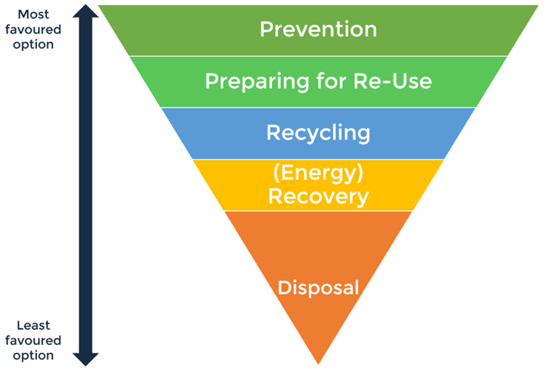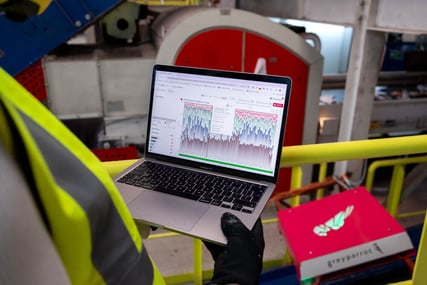In an ideal world, products designed with reuse and recovery in mind would reduce our reliance on recycling. In turn, recycling would return reusable resources to the circular economy, decreasing the amount of waste material sent to landfills and incinerators.
To tackle the waste crisis, we need to reduce production and consumption, adopt sustainable materials and reusable products, and recycle. Each process remains crucial in its own right, with the UN projecting that recycling facilities alone will help cut global plastic pollution by 20% in 2050.
When viewed as a connected ecosystem of processes, though, their impact is magnified even further. While the waste hierarchy pyramid is a useful visual tool, it may be more helpful to think of waste management in circular terms.
Understanding the waste hierarchy pyramid
The waste hierarchy pyramid is a guiding framework for sustainable waste management, organised from the most environmentally beneficial actions to the least.

It’s important to note that while there are ‘most’ and ‘least’ favoured options from an environmental standpoint, none of the layers can mitigate the waste crisis on their own. Real impact comes when they’re fully connected.
How a connected waste hierarchy creates a healthier value chain
The connected view of the waste hierarchy has yet to fully catch on. Despite impressive results in countries like Germany, where recycling rates are as high as 67%, some argue that recycling itself “doesn’t work” in the effort to manage the 2 billion+ tonnes of solid waste we generate each year.
"The scepticism surrounding recycling is often the result of viewing the process in isolation. Policy, product design and investment all mean that by the time material arrives at a recovery facility or recycling plant, it’s supposed to be there."
Mikela Druckman, CEO and co-founder of Greyparrot
Processes like recycling don’t exist in a vacuum. They’re just one stage in a long value chain of:
- Materials research
- Product design
- Waste regulation
- Resource recovery
- Material reprocessing
- Consumer behaviours
- Waste collections, and more.
Countries like Germany and South Korea owe a large part of their success to their adoption of a holistic view of the waste management hierarchy. They recognise that sustainable design, effective policymaking, reuse schemes and recycling aren’t isolated stages of the waste value chain — they’re closely connected.
As the waste hierarchy pyramid narrows, the volume of material should, too. With effective policies, prevention and reuse, the waste that reaches recycling facilities will be easier to recover. Recycling will then be an even more effective filter that diverts valuable resources from landfills and incinerators.
Maximised recycling efficiency ensures the only material we consider “waste” is the material that is truly un-recoverable, like medical waste, hazardous chemical containers, ceramics and more.
Reshaping the waste hierarchy, from pyramid to circle
At Greyparrot, we’re on a mission to decrease the environmental impact of waste, and improve recycling efficiency. We believe that the emphasis of waste strategies should be on reducing and reusing resources. We also know that such strategies will rely heavily on resource recovery, and the data gathered in the process.

Waste data makes each stage of the waste hierarchy more effective, from determining which materials to focus reduction and reuse strategies on, to improving recycling rates.
The data we gather with waste intelligence is helping to increase recycling and recovery rates, but platforms like Deepnest means it can offer a feedback loop for everything from recyclable packaging design to waste regulation and consumer behaviour campaigns.
What emerges is more of a circle than a pyramid: reducing the environmental impact of waste requires an approach that balances all aspects of the waste hierarchy, unified and validated by real-world data:
"I’m particularly excited about data informing stakeholders across the waste value chain, from producers to regulators and even consumers.
Waste intelligence won’t just help transform waste into valuable resources, it will change how we encourage prevention, design for re-use, and ensure that we only dispose of material that is truly non-circular."Mikela Druckman, CEO and co-founder of Greyparrot
Learn more about the technology behind waste intelligence – and how we gather the waste data that's transforming everything from prevention to disposal.

%20(1).jpeg?width=780&height=532&name=Stock-waste%20landscape%20(1)%20(1).jpeg)



.png?width=501&height=285&name=IMG_6004%20(1).png)